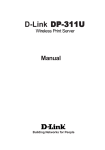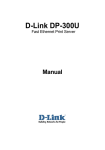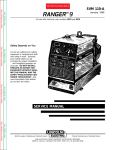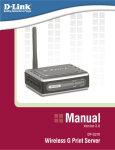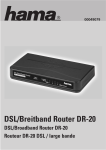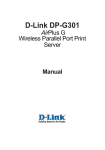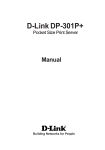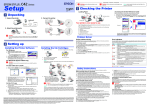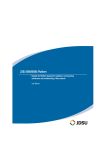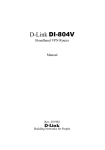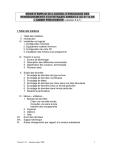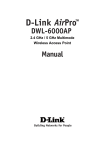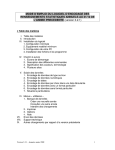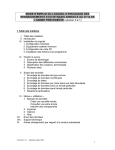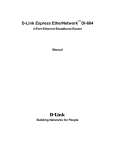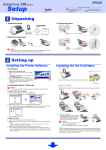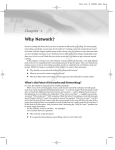Download D-Link DP-G321 User's Manual
Transcript
D-Link DP-G321 AirPlus G Wireless Print Server Manual Building Networks for People Contents Package Contents ................................................................................3 Introduction............................................................................................4 Wireless Basics ....................................................................................8 Installation Considerations ....................................................................9 Setting up the DP-G321 ......................................................................10 Power On Self Test .............................................................................. 11 Using the Web Configuration ...............................................................12 TCP/IP Printing for Windows XP ........................................................30 TCP/IP Printing for Windows 2000 .....................................................39 TCP/IP Printing for Windows 98SE/Me ..............................................49 Unix/Linux Printing (See PS Admin Manual on CD-ROM) ..................61 Setting up AppleTalk or LPR Printing in MAC OSX ..............................62 Setting up AppleTalk Printing in MAC OS9 ..........................................67 Printing from Mac OS Client Workstation.............................................68 Networking Basics ..............................................................................70 Technical Specifications ......................................................................82 Frequently Asked Questions ................................................................83 Contacting Technical Support ..............................................................84 Warranty and Registration ...................................................................85 Appendix: DP-G321 Printer Compatibility List .....................................88 2 Package Contents Contents of Package: D-Link DP-G321 Wireless Multi-port Print Server Manual and Warranty on CD Printed Quick Installation Guide If any of the above items are missing, please contact your reseller. System Requirements: A computer with an installed Ethernet adapter for initial configuration purposes only Windows XP/2000/Me/98SE, Mac OS with AppleTalk , or Linux A computer or a network of computers with wireless capability Internet Explorer 6.0, or Netscape Navigator version 6.0 or above, with JavaScript enabled The printer must support the required Operating System 3 Introduction The D-Link DP-G321 Print Server is an 802.11g wireless Multi-Port Print Server that allows you to connect your USB printer or parallel printer directly to your network. Now you can locate printer services virtually anywhere in your home or office. The DP-G321 manages the flow of print files from workstations or file servers to connected printers, delivering print jobs to printers much faster than a file server on a PC. The DP-G321 includes easy-to-use software to install on most Windows-based networks. Protocol support for TCP/IP, NetBEUI, and AppleTalk are provided to ensure seamless connection to major networking operating systems. The DP-G321 has a built in Web-based management feature that allows users to easily configure and manage print queues through TCP/IP. The DP-G321 provides a 10/100Mbps auto-sensing Ethernet port, allowing flexible attachment to either 10BaseT or 100BaseTX networks. With two USB 2.0 ports and one standard parallel port, the DP-G321 is an ideal wireless high-speed Print Server for a home or office that has multiple printers. The DP-G321 improves network printing services in the following ways: The DP-G321 delegates print jobs to the network printer. This provides workload relief to your file servers and allows the file servers’ full capacity to be used for file access or other direct services to network users. On peer-to-peer networks, workstations can print directly to the Print Server without increasing the load of another workstation or server. The DP-G321’s USB 2.0 ports can transmit data to high-speed laser printers much faster than a PC’s parallel printer port. With a separate parallel port, you will still have the option to use a standard parallel printer with the DP-G321. Because the DP-G321 is very portable and inexpensive compared to a PC-based print server, and the Print Server connects to your file servers through the network, printers can be deployed to locations of maximum convenience to users. 4 The DP-G321 offers extraordinary flexibility, operating with all major network operating systems and protocols: TCP/IP UNIX lpr/lpd Windows NT/2000, Windows 95/98SE/Me, Windows XP NetWare 5.x NDPS LPR Remote Printing NetBEUI Windows 2000/XP, Windows 95/98SE/Me, Microsoft LAN Manager, IBM LAN Server AppleTalk MacOS EtherTalk Windows-based setup and administration software, PS Admin, is supplied with the Print Server, making configuration and management quick and easy. The Print Server also supports configuration and management via the Telnet protocol for networks without Windows-compatible systems. External Features Port Connectors The DP-G321’s two USB ports and parallel port are located on its rear panel. The printer port can be configured using the PS Admin program or the print server’s Telnet interface. (See the PS Admin User’s Guide, available on the CD that came with the DP-G321, for information about configuring the print server’s ports.) The Print Server also supports web configuration permitting users to configure settings through the web browser. The default IP Address is as follows: Default IP Address – 192.168.0.10 Subnet Mask – 255.255.255.0 Note: The PC’s IP Address must be in the same subnet as the Print Server’s IP Address for the two devices to communicate. (For example, if your Print Server’s IP Address is 192.168.0.10, with a subnet mask of 255.255.255.0, then your computer’s IP Address should be 192.168.0.x, where x is a value between 1-254, excluding 10.) 5 Front Panel LED Indicators There are two front panel indicators, each holding two separate LEDs (aligned in a vertical position). As shown below, the first indicator holds the Power and the USB LED. The second indicator holds the Ethernet and WLAN LED. Upon boot-up, the Power light stays on continuously and all other LEDs light up momentarily one-byone, then turn off. Power A steadily lit LED indicates proper operation of the Print Server. Link/Activity A steadily lit LED indicates proper network connection; no lit LED indicates an unsuccessful network connection. A blinking LED indicates activity (configuration or printing). WLAN A steadily lit LED indicates a proper wireless network connection; no lit LED indicates an unsuccessful wireless network connection. A blinking LED indicates activity (configuration or printing). USB1 A steadily lit LED indicates that the Print Server is transferring print data to the USB1 printer port. USB2 A steadily lit LED indicates that the Print Server is transferring print data to the USB2 printer port. LPT A steadily lit LED indicates that the Print Server is transferring print data to the parallel printer port. Power WLAN Link/Act USB2 USB1 6 LPT Rear Panel Connectors Network Cable Connector The Print Server’s rear panel has a LAN port for CAT5 Ethernet cabling. The port supports the NWay protocol, allowing the Print Server to automatically detect or negotiate the transmission speed of the network. DC Power Connector The DC power input connector is located on the Print Server’s rear panel and is labeled DC 5V. Antenna LAN USB2 LPT USB1 7 Power Reset Wireless Basics D-Link wireless products are based on industry standards to provide easy-to-use and compatible high-speed wireless connectivity within your home, business or public access wireless networks. D-Link wireless products will allow you access to the data you want, when and where you want it. You will be able to enjoy the freedom that wireless networking brings. A wireless LAN (WLAN) is a cellular computer network that transmits and receives data with radio signals instead of wires. WLANs are used increasingly in both home and office environments, and public areas such as airports, coffee shops, and universities. Innovative ways to utilize WLAN technology are helping people to work and communicate more efficiently. Increased mobility and the absence of cabling and other fixed infrastructure have proven to be beneficial for many users. Wireless users can use the same applications they use on a wired network. Wireless adapter cards used on laptop and desktop systems support the same protocols as Ethernet adapter cards. People use wireless LAN technology for many different purposes: Mobility - Productivity increases when people have access to data in any location within the operating range of the WLAN. Management decisions based on realtime information can significantly improve worker efficiency. Low Implementation Costs – WLANs are easy to set up, manage, change, and relocate. Networks that frequently change can benefit from WLANs ease of implementation. WLANs can operate in locations where installation of wiring may be impractical. Installation and Network Expansion - Installing a WLAN system can be fast and easy and can eliminate the need to pull cable through walls and ceilings. Wireless technology allows the network to go where wires cannot go - even outside the home or office. Scalability – WLANs can be configured in a variety of topologies to meet the needs of specific applications and installations. Configurations are easily changed and range from peer-to-peer networks suitable for a small number of users to larger infrastructure networks to accommodate hundreds or thousands of users, depending on the number of wireless devices deployed. Inexpensive Solution - Wireless network devices are as competitively priced as conventional Ethernet network devices. 8 Wireless Basics (cont.) Standards-Based Technology Based on the IEEE 802.11g standard, the DP-G321 is interoperable with existing compatible 2.4GHz wireless technology with data transfer speeds of up to 54Mbps when used with other D-Link AirPlus G devices. Installation Considerations The D-Link AirPlus G DP-G321 lets you print through your network, using a wireless connection, from virtually anywhere within its operating range. Keep in mind, however, that the number, thickness and location of walls, ceilings, or other objects that the wireless signals must pass through, may limit the range. Typical ranges vary depending on the types of materials and background RF (radio frequency) noise in your home or business. The key to maximizing wireless range is to follow these basic guidelines: 1. Keep the antenna of the DP-G321 in an upright position. 2. Keep the number of walls and ceilings between the DP-G321 and other network devices to a minimum - each wall or ceiling can reduce your D-Link wireless product’s range from 3-90 feet (1-30 meters). Position your devices so that the number of walls or ceilings is minimized. 3. Be aware of the direct line between network devices. A wall that is 1.5 feet thick (.5 meters), at a 45-degree angle appears to be almost 3 feet (1 meter) thick. At a 2-degree angle it looks over 42 feet (14 meters). Position devices so that the signal will travel straight through a wall or ceiling (instead of at an angle) for better reception. 4. Building materials can impede the wireless signal - a solid metal door or aluminum studs may have a negative effect on range. Try to position wireless devices and computers with wireless adapters so that the signal passes through drywall or open doorways and not other materials. 5. Keep your product away (at least 3-6 feet or 1-2 meters) from electrical devices or appliances that generate extreme RF noise. 9 Setting up the DP-G321 Installing the Print Server WARNING: Configuration problems may result if the Print Server is powered up without first establishing its network connection. Follow this procedure to avoid complications at the configuration stage. 1. Confirm proper operation of your printer before connecting the DP-G321. 2. When you have confirmed proper operation of your USB or parallel printer, turn your printer power OFF. 3. Confirm that your network is operating normally. 4. Connect the DP-G321 to your network, using a straight-through CAT5 cable. 5. While the printer is powered OFF, use the USB or parallel printer cable to connect the DP-G321 to your printer. 6. Switch ON your USB or parallel printer. 7. Plug the DC power adapter into the DC 5V power socket on the rear panel of the Print Server. 8. Plug the power adapter into a power outlet. This will supply power to the DP-G321, as it has no external power switch. The green Power LED on the Print Server’s front panel should illuminate steadily, and the Print Server’s Self-Test will proceed. 10 Power ON Self-Test Every DP-G321 has been factory-tested to operate properly. When the DP-G321 is powered ON, it also automatically performs a Self-Test on each of its major components. The final result of the Self-Test is signaled by the state of the USB LED indicator following the Self-Test. Preliminary to the actual component tests, the LED indicators are tested to confirm their steady and flashing operation. Immediately after power-up, three of the green LEDs should illuminate steadily for several seconds. Then the USB LED should flash three times. Irregularity of the LED during this LED test may mean there is a problem with the LED itself. The actual component tests immediately follow the LED tests. A normal (no fault) result is signaled by a flashing of the USB LED, followed by a darkened LED. If the Self-Test routine detects any component error, then following the LED tests the Self-Test will halt and the LEDs will continuously signal the error according to the following table. USB LED Faulty Component low speed flashing Need to reload firmware steady ON DRAM error 1 long 2 short Timer INT error 1 long 3 short Flash Protected 1 long 5 short Flash Erase/Program error 1 long 6 short LAN Controller error 1 long 7 short LAN memory error 1 long 11 short LAN I/O base error 1 long 15 short Wireless LAN card detect error 1 long 16 short Wireless LAN card CIS error 1 long 17short Wireless LAN card I/O error 1 long 18 short USB error 11 Using the Web Configuration Please use an Ethernet connection for the configuration of the DP-G321. Using a CAT5 cable, connect the DP-G321 to the Ethernet-adapter equipped computer in your network that you will be using for configuration. Open your web browser and type http://192.168.0.10 in the address box, and press Enter. This set of numbers is the default IP Address of your Print Server. Please note that the PC’s IP Address must correspond with the Print Server’s IP Address in the same segment for the two devices to communicate. When you enter the default IP address, the main screen of the Print Server’s configuration will appear (see below). In addition to the product information, you can access and control the Print Server’s configuration through four links on the top of this main screen: Home, Configuration, Tools, and Help. 12 Using the Web Configuration (continued) Home Click on the Home tab from the tools bar of the main screen to display information about the DP-G321’s System Status and Printer Status. Home > System As shown here, the System displays the status of your print server, printer, and network. Clicking Refresh will update the information. Device Status: Information about the print server, including the firmware version, MAC/IP address, and the “up time” can be found in this field. Printer Status: The items in this field display information about the printer, such as the given name of the printer, speed, printer status, and the status of your printing tasks, etc. Ethernet Status: You can monitor the networking status in this field, including the network connection, speed, and the packets status. 13 Using the Web Configuration (continued) Home > Wireless Click the Wireless button in the left column to display information about the wireless LAN. Clicking Refresh will update the information. Wireless Status: The items in this field display information about the wireless LAN, such as the connection mode (Infrastructure or Ad-Hoc), SSID, channel, data transfer rate, WEP encryption, and the packets status. 14 Using the Web Configuration (continued) Home > Network Click the Network button in the left column to display information about the wireless LAN. Clicking Refresh will update the information. Auto IP: This field contains the current settings of TCP/IP, including DHCP/BOOTP, UPnP, and MAC Rendezvous. The items in this field are configured in Configuration > Network > TCP/IP. TCP/IP Printing: In this field, you can monitor the status of your printing tasks through TCP/IP. Microsoft Network Printing: In this field, you can monitor the status of your printing tasks through Microsoft Network. Mac AppleTalk Printing: In this field, you can monitor the status of your printing tasks through Mac AppleTalk. 15 Using the Web Configuration (continued) Home > User Click the User button in the left column to display the user’s information. Users Printing Log: The items in this field display the user(s) information, which include the user(s) Mac address, IP address, name, and status of printing tasks. 16 Using the Web Configuration (continued) Configuration Click on the Configuration tab from the tools bar of the main screen to enter the configuration page; it provides the configuration options that include System Device and Port Setting. System Device and Port Setting This option will show you settings required to configure the DP-G321 Print Server. Consult your printers owner manual for the PJL (Printer Job Language) and print speed supported on your printer. Click the Save button on the bottom of the configuration page to ensure the settings are updated and saved. 17 Using the Web Configuration (continued) Configuration > System Device and Port Setting System Device In this field, you can configure the basic information of your print server. Server Name: Assign a name to the print server. Location (optional): Assign a location for the print server. Admin contact (optional): Assign the Admin’s contact name for the print server. Password: Enter the Administrator password (3-8 characters). To set up the password, please enter the password in the New Password box, and then enter the same one again in the Confirm Again box. Port Settings In this field, you can assign the Port Name for the print server, and the description for the USB or printer ports. It also allows you to select the PJL Printer setting (Yes or No). NOTE: PJL (Print Job Language) has certain job requirements that must be met to work correctly. for more information, please refer to your printer’s manual. Configuration > Wireless 18 Using the Web Configuration (continued) Configuration > Wireless Wireless Interface Connection Mode: Select one of two connection modes: Infrastructure (default): Connect to an existing wireless AP or router in a WLAN. Ad-Hoc: Connect to wireless clients in the Peer-to-Peer mode. SSID: Assign the SSID in this box. You can manually input the name or select one from the pull-down menu. To search the available print server within the network, click the Site Survey button. Wireless Channel: Select the channel from the pull-down menu. The default setting is 6. Transmission Rate: Select the data transmit rate from the pull-down menu. The default setting is Fully Automatic. WEP Encryption This field allows you to configure the settings of data encryption. Please remember that the WEP key must be set before the data encryption is enforced. WEP Encryption: This option allows you to select Disable, 64-bit, and 128-bit for encryption setting. WEP Key Format: You can decide the network key to be encoded by ASCII (ASCII characters) or HEX (hexadecimal digitals). 64-bit WEP encryption uses a 10 hexadecimal character key. The WEP encryption key must match the WEP settings on your AP or wireless router to connect properly. Then, enter the key(s) for the network in the Key box (1-4). Advanced Setting Beacon Interval: Enter the number for the beacon interval in milliseconds. Preamble: This option allows you to set the length of the preamble. Setting options are: Long: set to 144 bits Short: set to 72 bits. Authentication Type: You can set the authentication type by selecting the settings: Open System, Shared Key, and Both. 19 Using the Web Configuration (continued) Network 20 Using the Web Configuration (continued) Configuration > Network TCP/IP This field contains three options that allow you to configure the TCP/IP setting: IP Address: This option allows you to set the IP address manually or automatically. When you choose Manually Assign, you should enter the related information in the following boxes, including IP Address, Subnet Mask, and Default Gateway.* DNS Server Address:* Input the DNS (Domain Name Server) IP address provided by your ISP. *These entries must be filled to enable E-mail base printing. UPnP: This option allows you to enable or disable UPnP mode. MAC Rendezvous: This option allows you to enable or disable MAC Rendezvous mode. Second HTTP Port: Select Enable or Disable. Port Number: Enter the Port Number if you have enabled the Second HTTP Port. (For remote Web configuration and IPP printing.) . Microsoft Network . Enter the name of the Workgroup that you want the print server associated with in this field. AppleTalk Enter the AppleTalk Zone name in the box. In the following options, enter the related configuration, such as the printer type. USB1 / USB2 / LPT Chooser Name: Display the print server name. Printer Type: Enter the printer’s type in this box. PostScript Level: Select from the pull-down menu (Level 1 or Level 2). Font Group: Select from the pull-down menu. TIP: Once you have changed the settings in each option, click Apply to store the settings. 21 Using the Web Configuration (continued) Configuration > User Printing Control By configuring the Enable User Printing Control option (Yes or No), the user in the User List is permitted to access the print server or not. Define Users You can add/delete the user(s) to/from the User List. The User List at the bottom of the screen displays the current defined user and related information for the print server. Click Apply to save the changes. 22 Using the Web Configuration (continued) Configuration > SNMP SNMP Management SNMP (Simple Network Management Protocol) is a set of protocols for managing complex networks. Community 1/2/3: Enter a name in the Name box, and configure the Access Right by selecting Read Only or Read/Write from the pull-down menu. Click Apply if you have made changes. 23 Using the Web Configuration (continued) Tools Click on the Tools link from the tools bar of the main screen to enter the Tools Page; it provides the control options that include Print Test, E-mail, Reset, Upgrade, and Backup. Tools > Print Test Print Test Click Test to print a test page from the selected USB or parallel port. 24 Using the Web Configuration (continued) Tools > Email E-mail Account You can assign an E-mail address to the print server, so that the print server can send out mail to administrator directly through the print server if any change is made. Enter the E-mail account in the Print Server E-mail Address box to enable this. Outgoing E-mail (SMTP) Server Address: Enter the server address that is used to send your E-mail in this box. If your mail server needs to verify the user when sending E-mail, the DP-G321 will apply the same Account Name and Password to the mail server as it does when receiving E-mail. E-mail Notification You can set the print server to send a message through E-mail when the printer status changes. To enable this function, set the Enable e-mail notification for printer status changing option to Yes. Then, input the administrator’s E-mail address in the Admin E-mail Address box. 25 Using the Web Configuration (continued) Tools > Reset Reset Click Apply to immediately reset the print server. Factory Reset Click Apply to reload the factory default settings of the print server. 26 Using the Web Configuration (continued) Tools > Upgrade Firmware Upgrade When a new version of firmware is available (e.g., downloaded from the manufacturer’s website), you can upgrade the firmware of your print server. Click Browse to locate the firmware file, then click Apply. 27 Using the Web Configuration (continued) Tools > Backup Backup Device Configuration to File Click Apply to backup your current configuration of the print server to file and then save in the computer. Restore Device Configuration from File You can reload a configuration that you saved before. Click Browse to point to the backup file, and then click Apply. 28 Using the Web Configuration (continued) Help Click on the Help link from the tools bar of the main screen to enter the Help Page. This page provides a link to D-Link’s support website. D-Link’s support website will provide the most up to date information on your DP-G321 Print Server. Please check the website regularly for product and firmware updates. Click on each topic for more information on any screen in the Web Configuration Utility. 29 TCP/IP Printing for Windows XP Open the web browser, and type in the IP Address of the DP-G321. For example, type http://192.168.0.10 into the Location or Address field. Press the Enter or (Return) Key. Note: The PC’s IP Address must be in the same subnet as the Print Server’s IP Address for the two devices to communicate. (For example, if your Print Server’s IP Address is 192.168.0.10, with a subnet mask of 255.255.255.0, then your computer’s IP Address should be 192.168.0.x, where x is a value between 1-254, excluding 10.) See Networking Basics: Assigning a Static IP Address in this manual to find out how to change an IP Address. 30 TCP/IP Printing for Windows XP (continued) At the Configuration window, write down the Port Names for future reference. You will need this information later in the configuration process. 31 TCP/IP Printing for Windows XP (continued) Select your Connection Mode. Enter the SSID of the remote access point or wireless router you wish to connect to. If you would like to set WEP Encryption, select the encryption level and the key here. Click Apply. 32 TCP/IP Printing for Windows XP (continued) When you select TCP/IP Protocol at the Network window, the screen below appears. (We recommend that you keep the default settings as shown.) If you need to make changes, make sure to click Apply after you have made the changes. (You may wish to make a note of the IP address.) 33 TCP/IP Printing for Windows XP (continued) Go to Start > Settings > Printers and Faxes > Add a Printer Click Next. 34 TCP/IP Printing for Windows XP (continued) Select Local Printer. Deselect Automatically detect and install my Plug and Play printer. Click Next. Select Create a new port. At the pull-down menu, highlight Standard TCP/IP Port. Click Next. Click Next. 35 TCP/IP Printing for Windows XP (continued) Type in the IP address of the Print Server (i.e. 192.168.0.10). The Port Name will automatically be filled in. Select Custom. Then click Settings. Select LPR. Input the Port Name of the port being used by the printer. Click OK. 36 TCP/IP Printing for Windows XP (continued) Click Next. Click Finish. Highlight the printer, as shown. If the desired printer is not on the list, click Have Disk and insert the printer driver disk that came with your printer to install the printer drivers. Click Next. 37 TCP/IP Printing for Windows XP (continued) At this screen, you can input a name for the printer. Click Next. Click Next. Click Finish. 38 TCP/IP Printing for Windows 2000 Open the Web browser, and type in the IP Address of the DP-G321. For example, type http://192.168.0.10 into the Location or Address field. Press the Enter or (Return) Key. Note: The PC’s IP Address must be in the same subnet as the Print Server’s IP Address for the two devices to communicate. (For example, if your Print Server’s IP Address is 192.168.0.10, with a subnet mask of 255.255.255.0, then your computer’s IP Address should be 192.168.0.x, where x is a value between 1-254, excluding 10.) 39 TCP/IP Printing for Windows 2000 (continued) At the Configuration window, write down the Port Names for future reference. You will need this information later in the configuration process. 40 TCP/IP Printing for Windows 2000 (continued) Select your Connection Mode. Enter the SSID of the remote access point or wireless router to which you wish to connect. If you would like to set WEP Encryption, select the encryption level and the key here. Click Apply. 41 TCP/IP Printing for Windows 2000 (continued) When you select TCP/IP Protocol at the Network window, the screen below appears. (We recommend that you keep the default settings as shown.) If you need to make changes, make sure to click Apply after you have made the changes. (You may wish to make a note of the IP Address.) 42 TCP/IP Printing for Windows 2000 (continued) Go to Start > Settings > Printers. Double-click on the Add Printer icon. Click Next. 43 TCP/IP Printing for Windows 2000 (continued) Select Local Printer. Click Next. Select Create a new port at the pull-down menu, highlight Standard TCP/IP Port. Click Next. 44 TCP/IP Printing for Windows 2000 (continued) Click Next. Type in the IP address of the Print Server in the Printer Name or IP Address field. The Port Name field will automatically be filled in. Click Next. Select “Custom.” Then click on Settings. 45 TCP/IP Printing for Windows 2000 (continued) Select LPR. Input the port name of the port being used by the printer. Click OK. Click Next. Click Finish. 46 TCP/IP Printing for Windows 2000 (continued) Highlight the printer, as shown. If the desired printer is not on the list, click Have Disk and insert the printer driver disk that came with your printer to install the printer drivers. Click Next. At this screen, you can input a name for the printer. Click Next. 47 TCP/IP Printing for Windows 2000 (continued) Select Do not share this printer. . Click Next. Select Yes to print a test page. Click Next. Click Finish. The printer is now ready for printing with Windows 2000 on your network. 48 TCP/IP Printing for Windows 98SE/Me Open the web browser, and type in the IP Address of the DP-G321. For example, type http://192.168.0.10 into the Location or Address field. Press the Enter or (Return) Key. Note: Your PC’s IP Address must be in the same subnet as the Print Server’s IP Address for the two devices to communicate. (For example, if your Print Server’s IP Address is 192.168.0.10, with a subnet mask of 255.255.255.0, then your computer’s IP Address should be 192.168.0.x, where x is a value between 1-254, excluding 10.) 49 TCP/IP Printing for Windows 98SE/Me (continued) At the Configuration window, write down the Port Names for future reference. You will need this information later in the configuration process. The Port Name shown here is only an example. 50 TCP/IP Printing for Windows 98SE/Me(continued) Select your Connection Mode. Enter the SSID of the remote access point or wireless router to which you wish to connect. If you would like to set WEP Encryption, select the encryption level and the key here. Click Apply. 51 TCP/IP Printing for Windows 98SE/Me(continued) When you select TCP/IP Protocol at the Network window, the screen below will appear. (We recommend that you keep the default settings as shown.) If you need to make changes, make sure to click Apply after you have made the changes. (You may wish to make a note of the IP address.) 52 TCP/IP Printing for Windows 98SE/Me (continued) Go to Start > Settings > Control Panel. Double-click on Network. Click Add. Highlight Client. Click Add. 53 TCP/IP Printing for Windows 98SE/Me (continued) At this window, click Have Disk. 1. Insert the DP-G321 CD-ROM into your CD-ROM drive. Select the letter representing the CD-ROM drive on your computer from the pull-down menu. 2. Double-click on the folder lpr. 4 2 3 3. Highlight lpr.inf. 4. Click OK. 1 Click OK to accept the location of the file. 54 TCP/IP Printing for Windows 98SE/Me (continued) Click OK. You should now be back to the Network Properties Page. Highlight LPR for TCP/IP Printing. Click Properties. 55 TCP/IP Printing for Windows 98SE/Me (continued) Click Add Port. Type in the IP Address of the DP-G321. Make sure the Port Name is accurate. (The Port Name at right is just an example.) Click OK. The Port name and IP Address will be displayed. (The Port Name at right is just an example.) Click OK. 56 TCP/IP Printing for Windows 98SE/Me (continued) Click OK. Windows will ask for a restart. Click Yes. 57 TCP/IP Printing for Windows 98SE/Me continued) Once your computer has rebooted, click on Start > Settings > Printers > Add Printer. When the Add Printer Wizard screen appears, click Next. Select Network Printer. Click Next. Type in the path if you know it, or click Browse. 58 TCP/IP Printing for Windows 98SE/Me (continued) At the next screen, browse for the printer port. Highlight the port as shown. (The Port Name in this window is just an example.) Click OK. If the network path is not specified, type in the IP Address of the DP-G321 and the Port Name. (The Port Name shown at right is just an example.) Select Yes or No, to answer the question: Do you print from MS-DOS based programs? Click Next. Highlight the printer, as shown. If your desired printer is not on the list, click Have Disk and insert the printer driver disk that came with your printer to install the printer drivers. Click Next. Click Next. 59 TCP/IP Printing for Windows 98SE/Me (continued) Select Yes to print a test page. Click Finish. Go to Start > Settings > Printers Check to see that your printer is installed. 60 Unix/Linux Printing Please refer to the PS Admin Manual on the CD included with your purchase for information on setting up the Print Server in Unix/Linux. 61 Setting up Apple Talk or LPR Printing in Mac OS X Note: Mac OS printing with this print server is supported by PostScript printers only! With Mac OSX you can use AppleTalk or LPR printers using IP protocols for printing through Print Servers. Follow the instructions below for setting up the Print Server. After attaching the Print Server to your network using the directions provided in the Quick Installation Guide, change the IP address of your Macintosh to access the Print Server’s web configuration. Open your System Preferences window and Click Network. At the Configure pull-down menu, select Manually. 62 Setting up Apple Talk or LPR Printing in Mac OS X (continued) The default IP address of the Print Server is 192.168.0.10. Manually change your IP Address to 102.168.0.x, where x is any number between 1 and 254 (except 10 which is the IP Address of the Print Server.) The IP Addresses and Subnet Mask shown here are examples only. Select the AppleTalk tab in this window and check Make AppleTalk Active. 63 Setting up Apple Talk or LPR Printing in Mac OS X (continued) To print, open a document and select File > Print from the menu. Select Edit Printer List from the Printer dialog box. Click Add Printer. 64 Setting up Apple Talk or LPR Printing in Mac OS X (continued) Select the printing protocol preferred, AppleTalk or LPR Printers using IP. In this example, AppleTalk has been selected. AppleTalk protocol: After selecting AppleTalk the Port Name of the Print Server will be displayed. The Port Name shown here is an example only. PS - 116688-U1 PS - 116688-U1 Laserwriter Laserwriter Click on the Port to which the PostScript printer is connected. Then select the printer model from the dialog box displayed here. Click Add Printer and the Printer Port configuration is complete. Select the Printer Port just configured in the Print window. Click Print to print your document. 65 Setting up Apple Talk or LPR Printing in Mac OS X (continued) LPR Printers using IP protocol: When you select LPR Printers using IP Protocol, this window will appear. Type the IP Address of the Print Server into the LPR Printer’s Address field. PS-116688 - U1 In the Queue Name field, type in the Port Name of the PostScript printer that is connected to the Print Server. The Port Name illustrated here is only an example. Select the printer model from the dialog box. In the Queue Name field, type in the Port Name of the PostScript printer that is connected to the Print Server. The Port Name illustrated here is only an example. Select the printer model from the dialog box. Click Add and the process is complete. Close all Print Center windows, select the Printer Port that was just selected. Click Print to print the document.Click Add and the process is complete. 66 Setting up Apple Talk Printing in Mac OS 9 Note: Mac OS printing with this print server supports PostScript printers only! The AppleTalk network protocol is used with computers using the MacOS operating system. It can be used for network communications over standard Ethernet or Fast Ethernet using the EtherTalk transport, or over a proprietary low-speed LocalTalk transport. Your Print Server can be used for network printing to PostScript printers. You can print from any MacOS computer connected to your Ethernet network, either directly using an EtherTalk connection, or indirectly through a LocalTalk-to-EtherTalk router. NOTE: The Chooser name of a printer connected to one of the Print Server’s ports is the same as its Port Name. If you are using AppleTalk printing, you will need to make sure that every Port Name is unique among all of the network printers in your AppleTalk zone. The Port Names shown in this manual are examples only. Setting up the Print Server for AppleTalk Printing To set up your Print Server so that it can be used for AppleTalk printing: Make sure the AppleTalk protocol is enabled in your Macintosh. Change the IP address on one of the computers on your network to 192.168.0.x, where x is any number between 11-254. Type 192.168.0.10 into the address field of your Web browser. 192.168.0.10 is the default IP Address of the DP-G321. Select the Network tab and scroll to the bottom to the AppleTalk protocol section. If your AppleTalk network is divided into AppleTalk zones, you will have to specify which zone the Print Server should be in. You should locate the Print Server in the same zone as most of the users who will be using it. If your network is not divided into zones, the AppleTalk Zone field should contain a single asterisk “*”. 67 Printing from Mac OS Client Workstations The exact procedure for selecting a PostScript printer connected to your Print Server may vary slightly, depending on what printer driver version you are using. The procedure described below assumes you are using the LaserWriter 8. To choose a printer connected to your Print Server as your Mac OS workstation’s default printer, Open the Chooser by selecting Chooser from the Apple menu. Select the LaserWriter 8 icon on the left. Make sure that AppleTalk is set to Active. A list of all networked PostScript printers will be displayed: Double-click the name of the Printer Port you wish to use. The Printer Ports shown are examples only. PS-116688-U1 68 Printing from Mac OS Client Workstations (continued) If you have not previously set this printer as the default, your computer will prompt you for a PostScript Printer Description file. Choose Select PPD. Select the appropriate printer description file for your printer. Click Open. (If your printer is not listed, click Generic to use a generic printer description.) If you wish to access this setting in the future, you can use the Setup button in the Chooser window. The selected printer will become your computer’s default printer. You may need to choose Page Setup in any applications you have open. 69 Networking Basics Using the Network Setup Wizard in Windows XP In this section you will learn how to establish a network at home or work, using Microsoft Windows XP. Note: Please refer to websites such as http://www.homenethelp.com and http://www.microsoft.com/windows2000 for information about networking computers using Windows 2000, ME or 98SE. Go to Start>Control Panel>Network Connections. When this screen appears, click Next. 70 Networking Basics (continued) Please follow all the instructions in this window: In this window, select the best description of your computer. If your computer connects to the Internet through a gateway/router, select the second option as shown. Click Next. 71 Networking Basics (continued) Enter a Computer description and a Computer name (optional). Click Next. Enter a Workgroup name. All computers on your network should have the same Workgroup name. Click Next. 72 Networking Basics (continued) Please wait while the Network Setup Wizard applies the changes. When the changes are complete, click Next. Please wait while the Network Setup Wizard configures the computer. This may take a few minutes. 73 Networking Basics (continued) In this window, select the best option. In this example, Create a Network Setup Disk has been selected. You will run this disk on each of the computers on your network. Click Next. Insert a disk into the Floppy Disk Drive, in this case drive A. Format the disk if you wish, and click Next. 74 Networking Basics (continued) Please wait while the Network Setup Wizard copies the files. Please read the information under Here’s how in the screen below. After you complete the Network Setup Wizard you will use the Network Setup Disk to run the Network Setup Wizard once on each of the computers on your network. To continue, click Next. 75 Networking Basics (continued) The new settings will take effect when you restart the computer. Click Yes to restart the computer. You have completed configuring this computer. Next, you will need to run the Network Setup Disk on all the other computers on your network. After running the Network Setup Disk on all your computers, your new wireless network will be ready to use. 76 Networking Basics (continued) How to assign a Name to your computer To name your computer, please follow these directions in Windows XP: Click Start (in the lower left corner of the screen). Right-click My Computer. Select Properties. Select the Computer Name tab in the System Properties window. You may enter a Computer Description (optional). To rename the computer and join a domain, Click Change. 77 Networking Basics (continued) How to assign a Name to your Computer In this window, enter the Computer name. Select Workgroup and enter the name of the Workgroup. All computers on your network must have the same Workgroup name. Click OK. How to find your IP Address in Windows XP The computers connected to your network must be in the same IP address range. To verify the IP address, please do the following: Right-click on the Local Area Connection icon in the task bar. Click Status. 78 Networking Basics (continued) How to find your IP Address in Windows XP This window will appear. Click the Support tab. Click Close. Assigning a Static IP Address in Windows XP/2000 Note: DHCP-capable routers will automatically assign IP addresses to the computers on the network, using DHCP (Dynamic Host Configuration Protocol) technology. If you are using a DHCP-capable router you will not need to assign static IP addresses. If you are not using a DHCP capable router, or you need to assign a static IP address, please follow these instructions: Go to Start. Double-click Control Panel. 79 Networking Basics (continued) Assigning a Static IP Address in Windows XP/2000 Double-click Network Connections. Right-click Local Area Connections. Double-click Properties. 80 Networking Basics (continued) Assigning a Static IP Address in Windows XP/2000 Click Internet Protocol (TCP/IP). Click Properties. Select Use the following IP address in the Internet Protocol (TCP/IP)Properties window. Input your IP address and subnet mask. (The IP addresses on your network must be within the same range. For example, if one computer has an IP address of 192.168.0.2, the other computers should have IP addresses that are sequential, like 192.168.0.3 and 192.168.0.4. The subnet mask must be the same for all the computers on the network.) Input your DNS server addresses. (Note: If you are entering a DNS server, you must enter the IP address of the Default Gateway.) The DNS server information will be supplied by your ISP (Internet Service Provider.) Click OK. 81 Technical Specifications Printer Connection Printer Port: USB 2.0 or Parallel Bidirectional Communication: Hewlett-Packard PJL (Printer Job Language) standard for bidirectional communication. Network Connection Network Standards: IEEE 802.3 10Base-T Ethernet, IEEE 802.11g Wireless Standard Network Data Transfer Rate: 10/100 Mbps (megabits per second), up to 54Mbps Network Connector: CAT5 cable Network Protocols Ethernet Frame Types: 802.2, 802.3, Ethernet II, SNAP (auto-switching) Transport Protocols: TCP/IP, NetBEUI, AppleTalk/EtherTalk, LPR,SMB TCP/IP Protocols Supported: BOOTP, SNMP, Telnet, TFTP, FTP, LPD, RARP, DHCP, IPP Management and Diagnostics Standard: SNMP MIBs: MIB-II (RFC 1213) Diagnostic LED Indicators: Power, LAN, USB, WLAN Environmental and Physical Power Supply: External power supply providing 5V, 2.5A DC Dimensions: 3.54" x 3.19" x 1.57" (90mm x 81mm x 40mm) Weight: approx. 5.19 oz. (147g) Operating Temperature: 32 to122°F (0 to 50°C) Storage Temperature: -13 to 131°F (-25 to 55°C) Humidity: 5% to 95% non-condensing Emissions: FCC Class B, CE Class B, VCCI Class B 82 Frequently Asked Questions Q: I am unable to establish a connection between my print server and my D-Link router. A: Verify that your connection between both units is good. Check for valid link lights on your router and your print server. You may be using a bad or incorrect cable. Q: I am unable to make a wireless connection between my wireless print server and my DLink router. A: Most wireless connection problems are either caused by distance between your print server and your router or your router may be using WEP encryption. For trouble shooting please remove any form of wireless encryption and move the products closer together. Q: My printer will not print when connected to my print server. A: Verify that your printer and your print server are compatible. Log into the Web based management and use the printing test function under Tools. If your printer fails to print the test page then your printer is not compatible with this print server. Q: My test page prints fine from the Web based management but prints out unreadable text when I try a Windows based test page. A: Illegible text is caused by incorrect or corrupted drivers 80% of the time. Please visit your printer manufactures web page and download the latest print drivers for your OS. Q: I have another manufacturer’s wireless router and can not get the print server to connect. A: You will need to first change the IP address of your print server to match that IP address scheme of your wireless router. Ex: D-Link uses “192.168.0.x” for its default IP scheme. Where “x” is a number between 2 to 254. Run PS Admin from a Windows based PC. This will allow you to connect to the print server and change its default IP from 192.168.0.10 to something that matches your wireless network. For testing connections make sure that you disable any WEP encryption on the wireless router. Q: I plug in my USB printer but the USB light does not turn on. A: Please be aware that your USB light will only illuminate when traffic is being passed across the USB port. If you would like to make sure that your printer is being detected by the print server, log into the Web based management and check the printer status. 83 Techni cal Support echnical You can find software updates and user documentation on the D-Link website. D-Link provides free technical support for customers within the United States and within Canada for the duration of the warranty period on this product. U.S. and Canadian customers can contact D-Link technical support through our website, or by phone. Tech Support for customers within the United States: D-Link Technical Support over the Telephone: (877) 453-5465 24 hours a day, seven days a week. D-Link Technical Support over the Internet: http://support.dlink.com email:[email protected] Tech Support for customers within Canada: D-Link Technical Support over the Telephone: (800) 361-5265 Monday to Friday 8:30am to 9:00pm EST D-Link Technical Support over the Internet: http://support.dlink.ca email:[email protected] When contacting technical support, please provide the following information: • Serial number of the unit • Model number or product name • Software type and version number 84 Warranty and Registration Subject to the terms and conditions set forth herein, D-Link Systems, Inc. (“D-Link”) provides this Limited warranty for its product only to the person or entity that originally purchased the product from: D-Link or its authorized reseller or distributor and Products purchased and delivered within the fifty states of the United States, the District of Columbia, U.S. Possessions or Protectorates, U.S. Military Installations, addresses with an APO or FPO. Limited Warranty: D-Link warrants that the hardware portion of the D-Link products described below will be free from material defects in workmanship and materials from the date of original retail purchase of the product, for the period set forth below applicable to the product type (“Warranty Period”), except as otherwise stated herein. 1-Year Limited Warranty for the Product(s) is defined as follows: Hardware (excluding power supplies and fans)One (1) Year Power Supplies and Fans One (1) Year Spare parts and spare kits Ninety (90) days D-Link’s sole obligation shall be to repair or replace the defective Hardware during the Warranty Period at no charge to the original owner or to refund at D-Link’s sole discretion. Such repair or replacement will be rendered by D-Link at an Authorized D-Link Service Office. The replacement Hardware need not be new or have an identical make, model or part. D-Link may in its sole discretion replace the defective Hardware (or any part thereof) with any reconditioned product that D-Link reasonably determines is substantially equivalent (or superior) in all material respects to the defective Hardware. Repaired or replacement Hardware will be warranted for the remainder of the original Warranty Period from the date of original retail purchase. If a material defect is incapable of correction, or if D-Link determines in its sole discretion that it is not practical to repair or replace the defective Hardware, the price paid by the original purchaser for the defective Hardware will be refunded by D-Link upon return to D-Link of the defective Hardware. All Hardware (or part thereof) that is replaced by D-Link, or for which the purchase price is refunded, shall become the property of D-Link upon replacement or refund. Limited Software Warranty: D-Link warrants that the software portion of the product (“Software”) will substantially conform to D-Link’s then current functional specifications for the Software, as set forth in the applicable documentation, from the date of original retail purchase of the Software for a period of ninety (90) days (“Warranty Period”), provided that the Software is properly installed on approved hardware and operated as contemplated in its documentation. D-Link further warrants that, during the Warranty Period, the magnetic media on which D-Link delivers the Software will be free of physical defects. D-Link’s sole obligation shall be to replace the non-conforming Software (or defective media) with software that substantially conforms to D-Link’s functional specifications for the Software or to refund at D-Link’s sole discretion. Except as otherwise agreed by D-Link in writing, the replacement Software is provided only to the original licensee, and is subject to the terms and conditions of the license granted by D-Link for the Software. Software will be warranted for the remainder of the original Warranty Period from the date or original retail purchase. If a material non-conformance is incapable of correction, or if D-Link determines in its sole discretion that it is not practical to replace the non-conforming Software, the price paid by the original licensee for the nonconforming Software will be refunded by D-Link; provided that the non-conforming Software (and all copies thereof) is first returned to D-Link. The license granted respecting any Software for which a refund is given automatically terminates. Non-Applicability of Warranty: The Limited Warranty provided hereunder for hardware and software of D-Link’s products will not be applied to and does not cover any refurbished product and any product purchased through the inventory clearance or liquidation sale or other sales in which D-Link, the sellers, or the liquidators expressly disclaim their warranty obligation pertaining to the product and in that case, the product is being sold “As-Is” without any warranty whatsoever including, without limitation, the Limited Warranty as described herein, notwithstanding anything stated herein to the contrary. Submitting A Claim: The customer shall return the product to the original purchase point based on its return policy. In case the return policy period has expired and the product is within warranty, the customer shall submit a claim to D-Link as outlined below: The customer must submit with the product as part of the claim a written description of the Hardware defect or Software nonconformance in sufficient detail to allow D-Link to confirm the same. 85 The original product owner must obtain a Return Material Authorization (“RMA”) number from the Authorized D-Link Service Office and, if requested, provide written proof of purchase of the product (such as a copy of the dated purchase invoice for the product) before the warranty service is provided. After an RMA number is issued, the defective product must be packaged securely in the original or other suitable shipping package to ensure that it will not be damaged in transit, and the RMA number must be prominently marked on the outside of the package. Do not include any manuals or accessories in the shipping package. D-Link will only replace the defective portion of the Product and will not ship back any accessories. The customer is responsible for all in-bound shipping charges to D-Link. No Cash on Delivery (“COD”) is allowed. Products sent COD will either be rejected by D-Link or become the property of D-Link. Products shall be fully insured by the customer and shipped to D-Link Systems, Inc., 17595 Mt. Herrmann, Fountain Valley, CA 92708-4160. D-Link will not be held responsible for any packages that are lost in transit to D-Link. The repaired or replaced packages will be shipped to the customer via UPS Ground or any common carrier selected by D-Link, with shipping charges prepaid. Expedited shipping is available if shipping charges are prepaid by the customer and upon request. D-Link may reject or return any product that is not packaged and shipped in strict compliance with the foregoing requirements, or for which an RMA number is not visible from the outside of the package. The product owner agrees to pay D-Link’s reasonable handling and return shipping charges for any product that is not packaged and shipped in accordance with the foregoing requirements, or that is determined by D-Link not to be defective or non-conforming. What Is Not Covered: This limited warranty provided by D-Link does not cover: Products, if in D-Link’s judgment, have been subjected to abuse, accident, alteration, modification, tampering, negligence, misuse, faulty installation, lack of reasonable care, repair or service in any way that is not contemplated in the documentation for the product, or if the model or serial number has been altered, tampered with, defaced or removed; Initial installation, installation and removal of the product for repair, and shipping costs; Operational adjustments covered in the operating manual for the product, and normal maintenance; Damage that occurs in shipment, due to act of God, failures due to power surge, and cosmetic damage; Any hardware, software, firmware or other products or services provided by anyone other than D-Link; Products that have been purchased from inventory clearance or liquidation sales or other sales in which D-Link, the sellers, or the liquidators expressly disclaim their warranty obligation pertaining to the product. Repair by anyone other than D-Link or an Authorized D-Link Service Office will void this Warranty. Disclaimer of Other Warranties: EXCEPT FOR THE LIMITED WARRANTY SPECIFIED HEREIN, THE PRODUCT IS PROVIDED “AS-IS” WITHOUT ANY WARRANTY OF ANY KIND WHATSOEVER INCLUDING, WITHOUT LIMITATION, ANY WARRANTY OF MERCHANTABILITY, FITNESS FOR A PARTICULAR PURPOSE AND NON-INFRINGEMENT. IF ANY IMPLIED WARRANTY CANNOT BE DISCLAIMED IN ANY TERRITORY WHERE A PRODUCT IS SOLD, THE DURATION OF SUCH IMPLIED WARRANTY SHALL BE LIMITED TO NINETY (90) DAYS. EXCEPTAS EXPRESSLY COVERED UNDER THE LIMITED WARRANTY PROVIDED HEREIN, THE ENTIRE RISK AS TO THE QUALITY, SELECTION AND PERFORMANCE OF THE PRODUCT IS WITH THE PURCHASER OF THE PRODUCT. Limitation of Liability: TO THE MAXIMUM EXTENT PERMITTED BY LAW, D-LINK IS NOT LIABLE UNDER ANY CONTRACT, NEGLIGENCE, STRICT LIABILITY OR OTHER LEGAL OR EQUITABLE THEORY FOR ANY LOSS OF USE OF THE PRODUCT, INCONVENIENCE OR DAMAGES OF ANY CHARACTER, WHETHER DIRECT, SPECIAL, INCIDENTAL OR CONSEQUENTIAL (INCLUDING, BUT NOT LIMITED TO, DAMAGES FOR LOSS OF GOODWILL, LOSS OF REVENUE OR PROFIT, WORK STOPPAGE, COMPUTER FAILURE OR MALFUNCTION, FAILURE OF OTHER EQUIPMENT OR COMPUTER PROGRAMS TO WHICH D-LINK’S PRODUCT IS CONNECTED WITH, LOSS OF INFORMATION OR DATA CONTAINED IN, STORED ON, OR INTEGRATED WITH ANY PRODUCT RETURNED TO D-LINK FOR WARRANTY SERVICE) RESULTING FROM THE USE OF THE PRODUCT, RELATING TO WARRANTY SERVICE, OR ARISING OUT OF ANY BREACH OF THIS LIMITED WARRANTY, EVEN IF D-LINK HAS BEEN ADVISED OF THE POSSIBILITY OF SUCH DAMAGES. THE SOLE REMEDY FOR A BREACH OF THE FOREGOING LIMITED WARRANTY IS REPAIR, REPLACEMENT OR REFUND OF THE DEFECTIVE OR NONCONFORMING PRODUCT. THE MAXIMUM LIABILITY OF D-LINK UNDER THIS WARRANTY IS LIMITED TO THE PURCHASE PRICE OF THE PRODUCT COVERED BY THE WARRANTY. THE FOREGOING EXPRESS WRITTEN WARRANTIES AND REMEDIES ARE EXCLUSIVE AND ARE IN LIEU OF ANY OTHER WARRANTIES OR REMEDIES, EXPRESS, IMPLIED OR STATUTORY. 86 Governing Law: This Limited Warranty shall be governed by the laws of the State of California. Some states do not allow exclusion or limitation of incidental or consequential damages, or limitations on how long an implied warranty lasts, so the foregoing limitations and exclusions may not apply. This limited warranty provides specific legal rights and the product owner may also have other rights which vary from state to state. Trademarks: D-Link is a registered trademark of D-Link Systems, Inc. Other trademarks or registered trademarks are the property of their respective manufacturers or owners. Copyright Statement: No part of this publication or documentation accompanying this Product may be reproduced in any form or by any means or used to make any derivative such as translation, transformation, or adaptation without permission from D-Link Corporation/D-Link Systems, Inc., as stipulated by the United States Copyright Act of 1976. Contents are subject to change without prior notice. Copyright© 2002 by D-Link Corporation/D-Link Systems, Inc. All rights reserved. CE Mark Warning: This is a Class B product. In a domestic environment, this product may cause radio interference, in which case the user may be required to take adequate measures. FCC Statement: This equipment has been tested and found to comply with the limits for a Class B digital device, pursuant to part 15 of the FCC Rules. These limits are designed to provide reasonable protection against harmful interference in a residential installation. This equipment generates, uses, and can radiate radio frequency energy and, if not installed and used in accordance with the instructions, may cause harmful interference to radio communication. However, there is no guarantee that interference will not occur in a particular installation. If this equipment does cause harmful interference to radio or television reception, which can be determined by turning the equipment off and on, the user is encouraged to try to correct the interference by one or more of the following measures: Reorient or relocate the receiving antenna. Increase the separation between the equipment and receiver. Connect the equipment into an outlet on a circuit different from that to which the receiver is connected. Consult the dealer or an experienced radio/TV technician for help. FCC Caution: Any changes or modifications not expressly approved by the party responsible for compliance could void the user’s authority to operate this equipment. This device complies with Part 15 of the FCC Rules. Operation is subject to the following two conditions: (1)This device may not cause harmful interference, and (2) this device must accept any interference received, including interference that may cause undesired operation. IMPORTANT NOTE: FCC Radiation Exposure Statement: This equipment complies with FCC radiation exposure limits set forth for an uncontrolled environment. This equipment should be installed and operated with a minimum distance of about 8 inches (20cm) between the radiator and your body. This transmitter must not be co-located or operated in conjunction with any other antenna or transmiter. Register your D-Link product online at http://support.dlink.com/register/ (06/15/04) 87 Appendix: DP-G321 Printer Compatibility List For Windows The Canon Printer The Lexmark Printer Canon BJC-55, 85 Canon S100SP Canon S200SP Canon S300 Canon S330 Canon S400SP Canon S450 Canon S520 Canon S600 Canon S750 Canon S4500 Canon S6300 Canon S9000 Lexmark Z13 Lexmark Z25 Lexmark Z33 Lexmark Z35 Lexmark Z43 Lexmark Z45 Lexmark Z53 The HP Printer The Epson Printer Epson Stylus Color 900 Epson Stylus Color 1160 Epson Stylus Color 2200 Epson Stylus Photo 720 Epson Stylus Photo 810, 820, 830, 890 Epson Stylus Photo 900 Epson Stylus Photo 1280, 1290 Epson Stylus C41UX, C405, C42UX Epson Stylus C60, C61, C62 Epson Stylus C80, C82 88 HP DeskJet 640C, 656C HP DeskJet 845C HP DeskJet 920C HP DeskJet 948C HP DeskJet 960C HP DeskJet 990Cxi, 995C HP DeskJet 1125C, 1180C HP DeskJet 1220C HP DeskJet 3320 HP DeskJet 3420, 3425 HP Color Inkjet CP1700 HP LaserJet 1200 HP LaserJet 2200, 2200d Appendix: DP-G321 Printer Compatibility List for Windows (continued) The Lexmark Printer Lexmark 4039 10R Lexmark 5700 Lexmark Optra Color 45 Lexmark Optra C710 Lexmark Optra E, E+, E310 Lexmark Optra K1220 Lexmark Optra M410, M412 Lexmark Optra N Lexmark Optra R+ Lexmark Optra S1250, S1855 Lexmark Optra SC-1275 Lexmark Optra SE-3455 Lexmark Optra T614 Lexmark Optra W810 Lexmark Z53 Other printers from the brands listed above may also be supported. For an updated compatibility list please visit: http://www.support.dlink.com 89

























































































